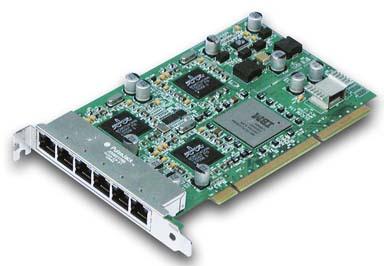- Related articles
- All Cisco SFP-10G-LR’s Information ( Overview, Features, Datasheet PDF, Price, Specificati
- Difference between 1000BASE-SX and 1000BASE-LX
- The difference between DWDM and OTN
- The difference between integrated network card and external network card
- The Things You Need to Know about 1000BASE-FX Ethernet Standards
- All Cisco DS-X2-FC10G-SR's information (List price, Specs, Datasheet PDF, Compatibility ma
- Applicable to 100BASE-FX Standard Optical Transceiver Models
- The difference between PCI and PCI Express
- Optical Transceivers for Cisco N3K-C3172PQ-XL Switch
- All Cisco MGBBX1's information (List price, Specs, Datasheet PDF, Compatibility matrix)

A network interface card (NIC) is a circuit board or card that is installed in a computer so that it can be connected to a network.
A network interface card provides the computer with a dedicated, full-time connection to a network. Personal computers and workstations on a local area network (LAN) typically contain a network interface card specifically designed for the LAN transmission technology.

Multiport Network Card
The multiport network card is an IEEE 802.3/u/ab standards compliant PCIe network adapter, which adds connections to up to four separate high-speed Gigabit networks from a single desktop client, server or workstation.
Suitable for any PCI Express enabled computer, this Gigabit Ethernet Network Adapter Card offers a practical, cost-effective resource for business, corporate or government environments, with support for high performance 4-channel networking and maximum throughput up to 1000Mbps in each direction (2000 Mbps total) - up to ten times faster than 10/100 Ethernet.
Compatible with a broad range of operating systems, this versatile PCIe Gigabit NIC is suitable for many SMB and Enterprise applications such as virtualized environments that require multiple NICs.
Optimizing Virtual Infrastructures by Using Multiport Network Card
The Multi-port server adapters showcase the latest virtualization technology that improves overall system performance by lowering the l/O overhead in virtualized environment. This optimizes CPU usage, reduces system latency, and improves l/O through put.
Use of multi-port adapters in virtualized environment is very important because of the need to provide redundancy and data connectivity for the application/workloads in the virtual machines. Due to slot limitations and the need for redundancy and data connectivity, it is recommended the virtualized physical serve need at least six GbE ports to satisfy the l/o requirement demands.
For mission-critical application, where dedicated l/O is required for maximum network performance, users can assign a dedicated virtual function port for a VM. The controller provides direct VM connectivity and data protection across VMs using SR-lOV. SR-lOV technology enables the data to bypass the software virtual switch and provides neat-native performance. it assigns either physical or virtual l/O ports to individual VMs directly.
Summary
Using virtualization to consolidate physical servers, storage, and networks; improve resource utilization; and streamline business continuity processes is an increasingly popular strategy undertaken by organizations struggling to contain IT costs. To optimize the benefits of virtualization, multi-port server adapters can be an essential hardware component that helps ensure availability, reliability, and performance within a virtual infrastructure.





















































